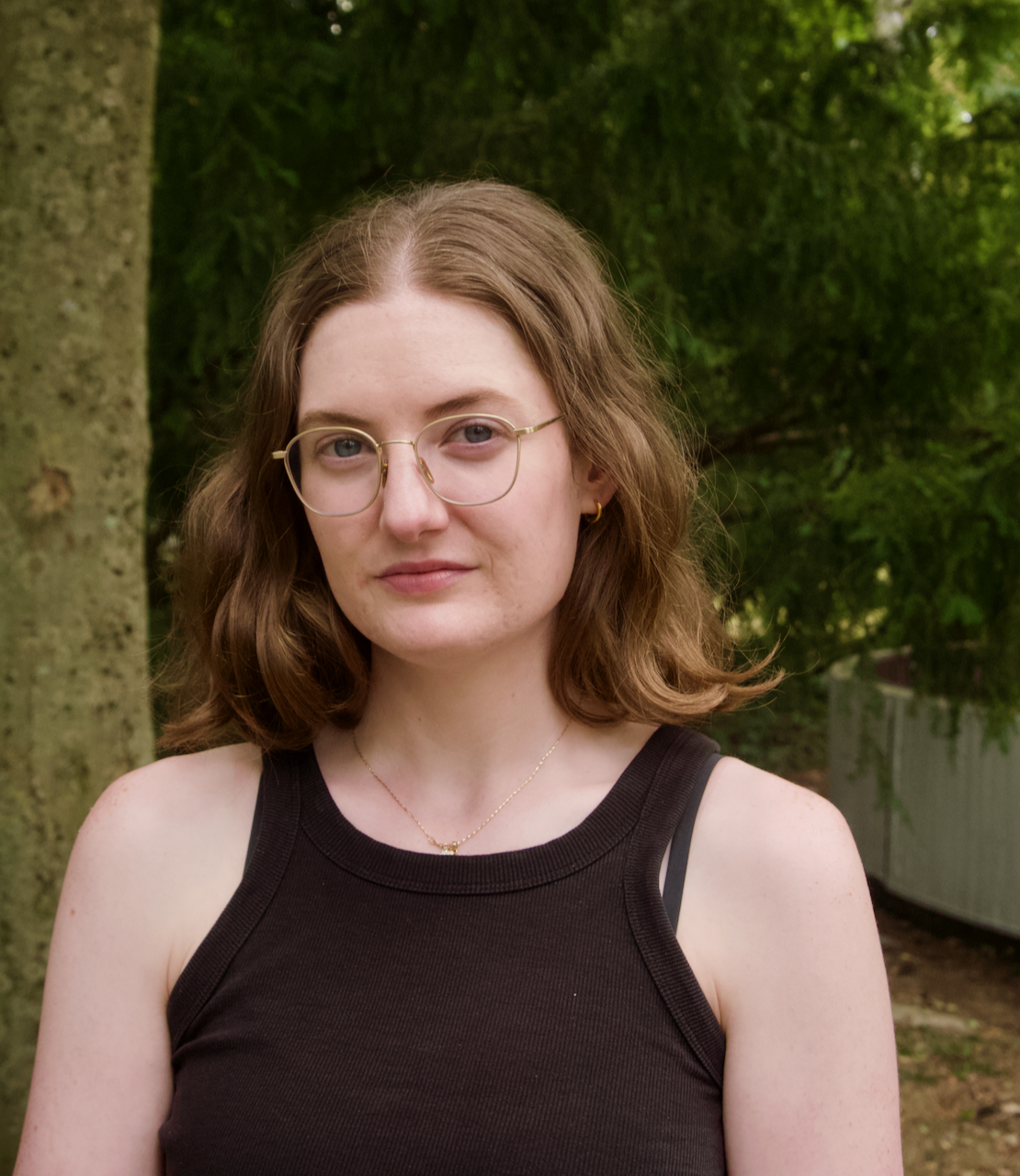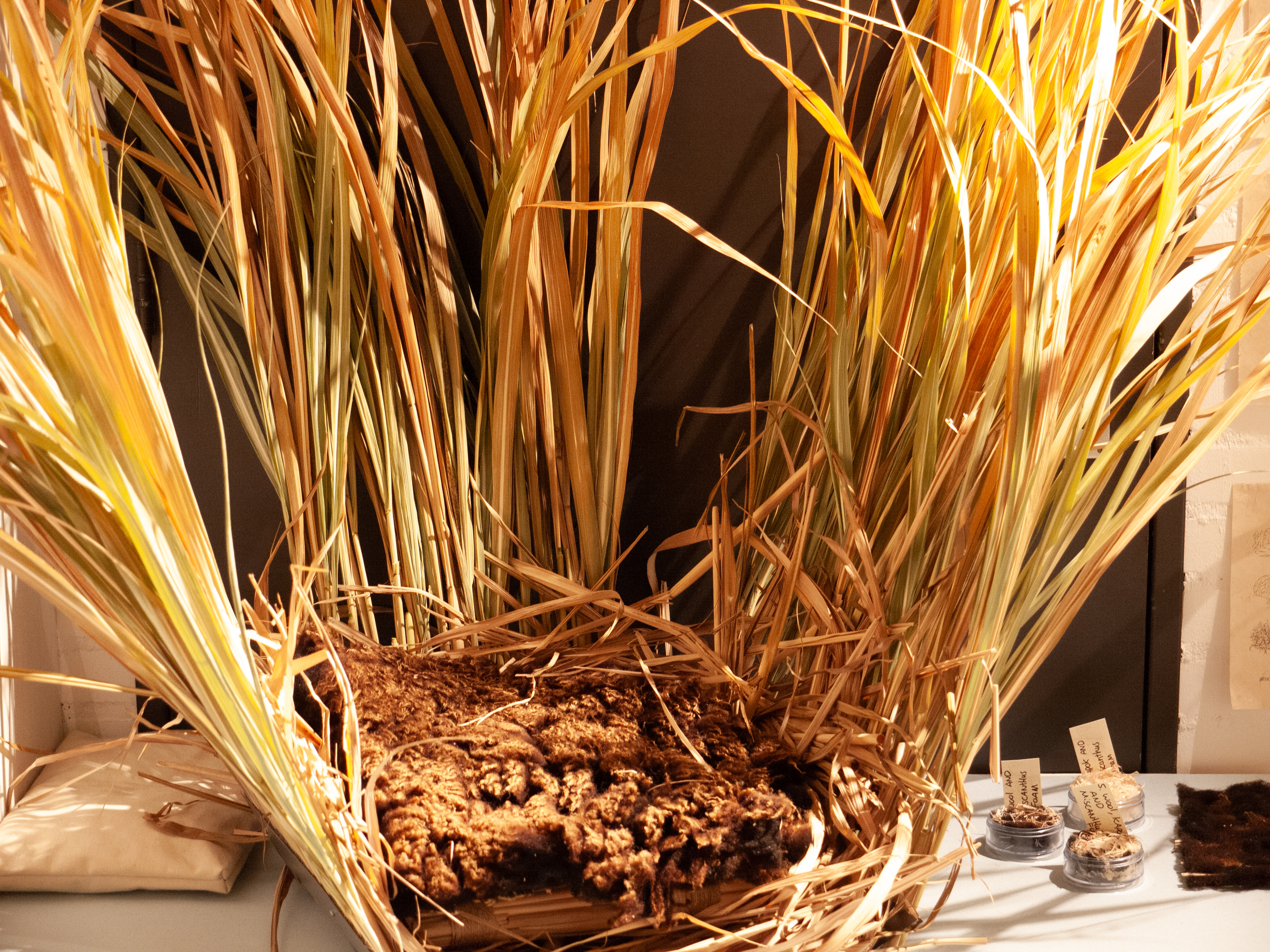My name is Lilian Beentjes, and I am currently completing my Master of Fine Arts at the Piet Zwart Institute. I hold a Bachelor's degree in Fine Arts & Education from the Amsterdam University of the Arts. My visual work has been exhibited at Tale of a Tub in Rotterdam, Museumnacht Amsterdam, and Rosalux in Berlin. Over the past two years, I have also performed my musical work at Operator Radio, Koda, and Day Collective. In addition to my artistic practice, I have worked as a guest teacher at the HKU Fine Art department and the DBKV program at the Breitner Academie. Currently I’m creating and hosting jewellery workshops at de Doelen Studio’s.
Can you describe your graduation project and its main focus?
Magenta mesh shapen by MDF squares and circles, Greyish blue tule flowering up towards the sky out of a steel pipe, flexible matter pinched by chenille wires, a paper mâché panel lifted off the ground by blocks of plaster. Sheets of watercolour paper nearly collapse. The cracking sound and a singing voice add colour to the symphony. A glistening yellow glass bead in the corner of my eye. Sculptures are band members, jewellery tuns into instruments, sometimes they switch back to being just objects. Nothing is fixed.
My graduation project encapsulates a playful and intimate non-verbal dialogue with the materials around me, researching their physical potentials through a process-based practice. I’ve explored the forms of agency between myself, matter and the outside world and, simultaneously, how these elements affect each other. This could be done through actions such as welding, sewing, singing or making glass beads, resulting in sculpture, jewellery, painting, writing, sound, and music. The materials I use stem from varied sources, such as hobby stores, drugstores, traditional art supplies, and hardware shops. Regardless of their origin, I try to combine and treat them in ways that resist hierarchy, allowing each to exist with equal value. I’m interested in what a material can become, rather than their prescribed functions.
The unfixed, non-hierarchical approach resonates with new materialist thinking, which proposes a reconceptualisation of the material world by decentralising the human. This movement challenges the notion of passive matter and instead acknowledges the vitality and agency of all things. The active potential of matter, therefore reveals the unstable identity of things and people, since nothing is set in stone anymore. The new materialistic context challenges hierarchies, power, positions and definitions of the material reality we inhabit. In doing so, new materialism opens up more fluid ways of relating to the world. These ideas are closely woven into my practice. Through the act of making and reflecting, connections emerge between material/ immaterial, language/non-verbal, brain/body, giver/receiver.
What inspired you to choose this particular subject or theme?
It wasn’t one specific element that inspired my graduation work, but rather a moment within an ongoing chain reaction. My hands move in ways I can’t always explain with words, creating a rhythm that feels both structured and freeing.However, I did have a clear desire of prioritising joy and play during my graduation project.
Artists like Karla Black inspired me to embrace that playful approach to matter. When I look at her practice, I see freedom and play, yet a deep seriousness in how she treats her materials. I was curious what would happen if I allowed myself fully to hold this non-verbal playground in my own studio practice.
To find that joy, I traced back to my upbringing. I grew up in a household where people liked to create. Building amplifiers, painting, playing piano, crocheting, constructing bikes, jewellery making, writing poetry, producing music and embroidery were all part of our everyday world. What all these activities have in common is the material intervention and using the body to create. This material engagement took place during moments of joy and compassion. Making did not need to succeed in achieving certain goals. It certainly did not need to make sense or havedirect meaning. I wanted to bring that same intuitive and sensual energy, present both in the making and the material, into an art institution like the Master Fine Arts program of PZI.
How did you develop and refine your ideas throughout the project?
Writing the thesis, with the help of my tutors, really helped me positioning my work. Thinkers like Jane Bennett, Judith Butler, Karen Barad, and Steven Knott gave me language and insight into processes that are usually non-verbal for me. Writing about my practice has grounded and deepened the making side of my work. Matter often seems like the opposite of language, and intuition the opposite of analysis. However, by engaging with philosophy, perspective of other artists and writers that aligned with feminist and/or new materialist theory, I was able to translate material and intuitive processes into words and perspectives.
These two years at Piet Zwart, I also had the opportunity to learn new material skills and techniques. I experimented with craft-based practices and tried to make the methods my own. Crafts like woodcarving and lamp working carry rich histories and involve precise techniques. I approached these practices using the materials and tools available to me. Carving and assembling MDF sheets, making glass beads without a kiln, or creating casts out of paper; resulting in more DIY outcomes. I had a lot of fun exploring what emerged from these processes, and they’ve become newer elements within my work.
As you approach graduation, what challenges have you encountered in completing your project?
Sometimes, it was a challenge to stay mindfully engaged with the sculptures and materials around me. Feeling the pressure of graduating, I began placing heavy demands on how the sculptures and sound works should look. This harshness occasionally created a sense of distance between me and the matter, blocking an intuitive approach. Studio visits with tutors and peers helped me reconnect with what I already had in the studio. I began incorporating older works, re-cycling sculptures to rekindle a sense of compassion for the materials around me. This led to a more open and playful approach—like my studio had become an active closet full of garments, where I could assemble new outfits each day and create new pieces to add to the collection.
What aspects of your project are you most excited about?
I'm excited to see the works in dialogue with one another. The graduation exhibition will take place at TENT, and I’m curious how the pieces will respond to the space—and how the space will respond in return. Materials are so sensitive to proximity, scale, height, and volume; I look forward to seeing how they influence each other, especially in combination with sound embedded within the installation. I will also perform my music during the exhibition, which will add a new context to the sculptural environment—something I’m very much looking forward to as well.
Are there any specific concerns or obstacles you're currently facing?
The hardest part for me will always be to make compositional and curatorial decisions. With a process based practice, a lot of gestures and ideas are allowed to float through the space. Yet at certain moments, you need to gather and arrange your research in order to present it. The endless possibilities of what and how to show is a rewarding experience, but they also require the artist to take responsibility and make choices. Do I incorporate sound into my sculptural work? Do the pieces want to be close together, or do they need space? What is the relationship between scale and material? What should the title communicate? The challenge is to stay focused on my intrinsic intentions, and to let those intentions be held and reflected by the work itself.
How has your experience at PZI contributed to your growth?
The tutors of the MFA encouraged me to let my multiple practices merge together occasionally. Before I entered Piet Zwart, I saw my music, sculptures, writing and teaching practices as separate islands that did not belong to each other. The tutors and peers have helped my recognise the overlapping patterns and rhythms within these disciplines, and encouraged me to explore versions where they can exist in the same realm, like musical performances or pairing lyrics with more essayistic writings within my thesis.
Going into this MFA one of my goals was also to get a better sense of my vision as a teacher as well. I felt my teaching ambitions were so separated from what I wanted to make as an artist. Having gained a better understanding of the mechanics behind my own practice has helped shape me as a teacher as well. I want to encourage physical engagement with the material world around us, just like I try within my own practice. During my jewellery workshops I focus on one material per session, creating something with our hands. I notice the focus, mindfulness and re-appreciation for creativity within the participants. Gaining knowledge by using the body as a tool, is an important counterpart for the digital and busy environment we find ourselves in today.
Looking back, how have you evolved since your first year in the program?
I began exploring more formal aspects of my work, such as scale. By creating large-scale sculptures alongside tiny glass beads, I experienced how the body moves differently through varying dimensions. This led me to question what scale truly means, whether it’s limited to the metric measurements of a sculpture, or if it can also refer to the volume of sound, or the cumulative presence of smaller parts. Engaging with this idea has deepened and enriched my understanding of my practice.
In what ways has your time at WdKA prepared you for this final project?
On a very practical level, I got access to a lot of workshops and stations. For example, being able to frequently make use of the metal station has helped me to gain knowledge and confidence about welding, assembling metal and lamp working with glass. Since the core of my practice is matter, creating new ways to engage with material automatically enriches the palet of my work.
Have there been mentors or resources that have significantly influenced your work?
All the tutors have been so helpful to my practice and work. Each of them have such a unique entry point in which we can talk about my work and the themes I’m interested in. Some are very material based, others more philosophical or conceptual. It has been really insightful to touch upon themes and elements related to my practice, in order to understand and develop the research.
What are your immediate plans after graduation?
I’d like to explore the different practices even further. I’m esspeccialy keen on focussing on making jewellery and getting more skilled in that department.
The MFA helped me developing my position as a teacher. I’m looking forward to share my love for making and creating with others, through workshops and other educational outlets. Right now I’m really happy with creating and hosting jewellery workshops at de Doelen Studio’s, and I’m building to share my knowledge and guidance through other platforms as well in the future.
Do you have any advice for current or prospective students in your program?
In hindsight, I see how important it is to take time and stay true to what genuinely interests you. In the past, I sometimes struggled to make space for a practice that isn’t heavily language-based, assuming it wasn’t ‘smart’ enough. I’ve since found liberation in allowing myself to follow my intuition and to assign value to every creative outlet I work in. Approaching your practice this way can make your time in the MFA program truly worthwhile.


